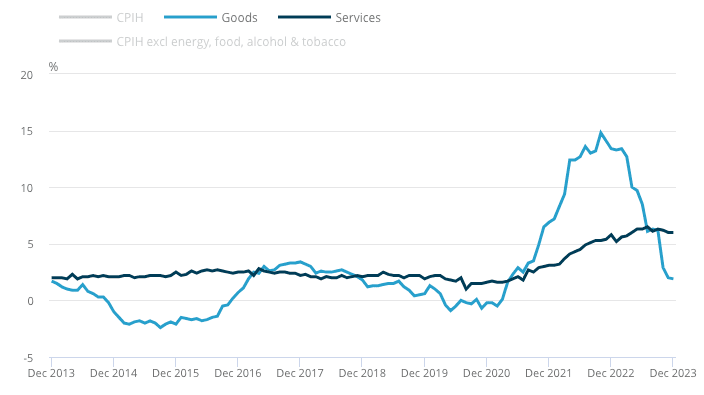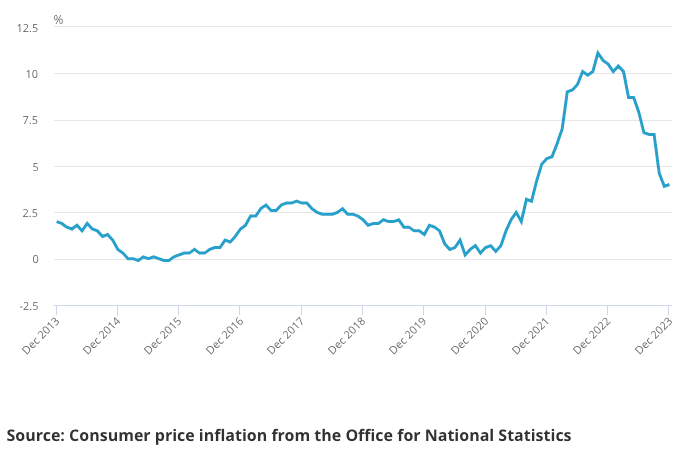Pound Sterling Rallies on Unexpected Rise in Inflation
- Written by: Gary Howes
-

Image © Adobe Stock
The British Pound rose across the board after UK inflation for December rose by more than expected, leading markets to cool expectations for imminent Bank of England interest rate cuts.
Markets were positioned for the Bank to cut rates as soon as March, but the ONS reported headline CPI inflation increased from 3.9% in November to 4.0% year-on-year in December, beating consensus expectations for another fall to 3.8%.
The rise was helped by a 0.4% month-on-month increase from -0.2% previously, which was stronger than the 0.2% rise the market expected.
Core inflation rose 5.1% y/y in December, unchanged on the previous month and exceeding estimates of 4.9%. This was driven by a m/m increase of 0.6%, up from -0.3% and ahead of consensus expectations for 0.4%.
The inflation data suggests market expectations for Bank of England rate cuts would need to retreat, which can support UK bond yields and the Pound.
The Pound to Euro exchange rate rose in the minutes following the release to print at 1.1630, and the Pound to Dollar exchange rate rose 0.3% in the minutes following the release to 1.2633. "Sterling maintains its lead in G10, supported by the 12bp spike in 2y and 10bp rise in 10y Gilt yields," says Kenneth Broux, a strategist at Société Générale.
"Though this increase does not take the figure drastically higher, it shows that the UK’s battle against inflation is not yet over and the situation remains precarious," says Richard Carter, head of fixed interest research at Quilter Cheviot.
Expectations for a downside surprise were boosted by a number of economic predictions made over the past week that UK inflation would fall back to the 2.0% target as early as April.
Indeed, trends of late - recall October and November's bigger-than-expected falls - suggested inflation was on course to reach this destination.
Above: GBP to EUR at one-minute intervals showing the initial market reaction. Track GBP and USD with your custom rate alerts. Set Up Here.
The Bank of England has nevertheless cautioned against complacency, and today's surprisingly hot figure will justify the Bank's preferred stance to keep rates level for an extended period.
"Not only has the headline rate of inflation seen an unwanted uptick, but Core CPI (excluding energy, food, alcohol and tobacco) still remains relatively high. Core inflation has been falling much more gradually than the headline figure and now sits at 5.1%, holding steady at the same rate as November. Progress here is likely to be slow, so the Bank may resist making rate cuts until it returns to a more palatable level," says Carter.
Above: Goods inflation is falling, but services inflation remains 'sticky'. Chart: ONS.
The Pound has been one of 2024's better-performing major currencies, helped by a firming in UK interest rate cut expectations.
These inflation data will add to expectations that the Bank won't be able to cut rates as aggressively as market expectations had signalled, offering further support to the currency.
"Pretty comfortable with my call for August for the first cut in UK bank rate. CPI was never likely to slow in a straight line - & April indexation event still to navigate. Market pricing for an early Spring cut will drift on this data," says Simon French, Chief Economist at Panmure Gordon.
But, Viraj Patel, an analyst at Vanda Research, says he still sees enough evidence to suggest the Bank will cut interest rates in March.
He says 43% of the inflation basket still saw price cuts, with the trimmed mean measure reading at 0.2% m/m.
"This isn't a broad uptick in prices. It's a few sticky factors that I expect will fade in Q1. March still live for BoE cut," says Patel. If Patel is right, the market will at some point in the coming weeks rapidly raise interest rate cut bets again, which would weigh on the Pound, all else being equal.
Above: UK headline CPI inflation, year-on-year.
Michael Hewson, Chief Market Analyst at CMC Markets, says all signs now point to a June rate cut. He explains that today’s UK inflation numbers serve to reinforce the challenge facing the Bank of England in returning inflation to target and show that the process is unlikely to be linear. "Q1 was never a realistic probability," says Hewson of previous market expectations for the timing of a first cut.
He notes market pricing to reveal investors have pushed back the timing of the first cut to the middle of the summer, which underscores the Pound's outperformance on the day.
Hewson explains that even if inflation were to fall to the Bank's 2.0% target by the beginning of the second quarter, it won't be until May when such a fall is revealed.
"Which means the possibility of a May cut is ambitious," he explains.








